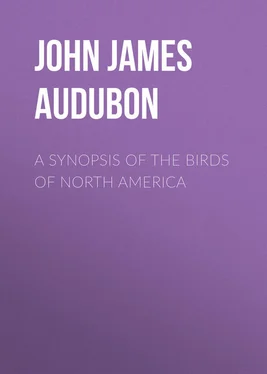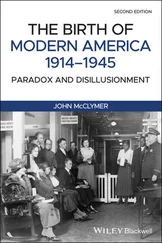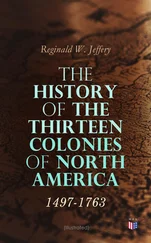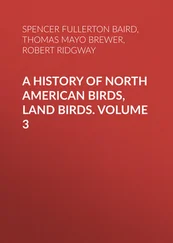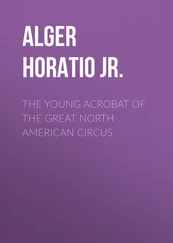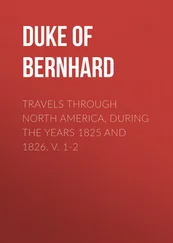John Audubon - A Synopsis of the Birds of North America
Здесь есть возможность читать онлайн «John Audubon - A Synopsis of the Birds of North America» — ознакомительный отрывок электронной книги совершенно бесплатно, а после прочтения отрывка купить полную версию. В некоторых случаях можно слушать аудио, скачать через торрент в формате fb2 и присутствует краткое содержание. Жанр: foreign_antique, foreign_prose, на английском языке. Описание произведения, (предисловие) а так же отзывы посетителей доступны на портале библиотеки ЛибКат.
- Название:A Synopsis of the Birds of North America
- Автор:
- Жанр:
- Год:неизвестен
- ISBN:нет данных
- Рейтинг книги:5 / 5. Голосов: 1
-
Избранное:Добавить в избранное
- Отзывы:
-
Ваша оценка:
- 100
- 1
- 2
- 3
- 4
- 5
A Synopsis of the Birds of North America: краткое содержание, описание и аннотация
Предлагаем к чтению аннотацию, описание, краткое содержание или предисловие (зависит от того, что написал сам автор книги «A Synopsis of the Birds of North America»). Если вы не нашли необходимую информацию о книге — напишите в комментариях, мы постараемся отыскать её.
A Synopsis of the Birds of North America — читать онлайн ознакомительный отрывок
Ниже представлен текст книги, разбитый по страницам. Система сохранения места последней прочитанной страницы, позволяет с удобством читать онлайн бесплатно книгу «A Synopsis of the Birds of North America», без необходимости каждый раз заново искать на чём Вы остановились. Поставьте закладку, и сможете в любой момент перейти на страницу, на которой закончили чтение.
Интервал:
Закладка:
Male , 5, 61/2. Female.
Throughout the United States. Abundant. Migratory.
American Redstart, Muscicapa Ruticilla, Wils. Amer. Orn. v. i. p. 103.
Muscicapa Ruticilla, Bonap. Syn. p. 68.
American Redstart, Muscicapa Ruticilla, Aud. Amer. Orn. v. i. p. 202; v. v. p. 428.
American Redstart, Muscicapa Ruticilla, Nutt. Man. v. i. p. 291.
GENUS V. PTILOGONYS, Swains. PTILOGONYS
Bill short, rather strong, somewhat triangular, depressed at the base, a little compressed at the end; upper mandible with the dorsal line convex at the end, the nasal groove wide, the sides convex toward the end, with a distinct notch, the tip short, rather obtuse; lower mandible with the angle rather long and wide, the dorsal line ascending and convex, the sides convex toward the end, the tip small, with a slight notch behind. Nostrils linear, oblong, partially concealed by the feathers. Head ovato-oblong; neck rather short; body slender. Feet short, and rather slender; tarsus shorter than the middle toe with its claw, compressed, covered anteriorly with a long plate and three inferior scutella; toes free, the outer only adherent at the base; hind toe rather large, stouter, outer a little longer than inner; claws moderate, arched, much compressed, laterally grooved, acute. Plumage soft and blended; slight bristles at the base of the upper mandible, and the feathers in the angle of the lower jaw bristle-tipped and curved forward. Wings long, rounded; first quill very small, fourth longest. Tail very long, straight, emarginate, and rounded, of twelve feathers.
This genus seems to connect the Thrushes with the Flycatchers.
69. 1. Ptilogonys Townsendi, Aud. Townsend's Ptilogonys
Plate CCCCXIX. Fig. 2. Female.
General colour dull brownish-grey; quills and coverts dusky brown; edge of wing dull white; basal part of primaries pale yellow, of secondaries ochre-yellow; edges of all the quills dull greyish-white; secondaries with a faint patch of light brownish-grey on the outer web toward the end; middle tail-feathers greyish-brown, the rest blackish-brown, the outer with an oblique white space, including, from the tip, a considerable portion of the inner web, and more than two-thirds of the outer; the next with a white patch at the end; lower parts paler than the upper; lower tail and wing-coverts broadly tipped with dull white, some of the inner wing-coverts white.
Female , 81/4, wing, 41/2.
Columbia River.
Townsend's Ptilogonys, Ptilogonys Townsendi, Aud. Orn. Biog. v. v. p. 206.
GENUS IV. CULICIVORA, Swains. GNAT-CATCHER
Bill of moderate length, depressed at the base, rapidly attenuated, becoming very slender toward the end; upper mandible with the ridge distinct, the tip extremely narrow and deflected, the edges overlapping, the notch distinct, but very small; lower mandible with the angle of moderate length, the ridge narrowed towards the end, the edges inclinate, the tip acute. Nostrils oblong, exposed. Head ovate; neck short; body slender. Feet of moderate length, tarsus longer than the middle toe, extremely slender, with the upper scutella indistinct; toes very small, extremely compressed; hind toe proportionally very large; outer adherent at the base. Claws well arched, extremely compressed, laterally grooved, acute. Plumage very soft and blended. Wings of moderate length, concave; the first quill about a third of the length of the second, fourth longest, third and fifth little shorter. Tail long, slender, much rounded.
70. 1. Culicivora cœrulea, Lath. Blue-grey Gnat-catcher
Plate LXXXIV. Male and Female.
Upper parts bright blue, deeper on the head, paler on the tail-coverts; a narrow black band on the forehead, extending over the eyes; wings brownish-black, margined with blue, some of the secondaries with bluish-white; tail glossy black, the outer feather on each side nearly all white, the next with its terminal half, and the third with its tip of that colour; lower parts greyish-white. Female similar, but with the tints duller, and the black band on the head wanting.
Male , 41/2, 61/2.
From Texas northward. Abundant. Migratory.
Blue-grey Flycatcher, Muscicapa cœrulea, Wils. Amer. Orn. v. ii. p. 164.
Sylvia cœrulea, Bonap. Syn. p. 85.
Blue-grey Sylvan Flycatcher, Muscicapa cœrulea, Nutt. Man. v. i. p. 297.
Blue-grey Flycatcher, Muscicapa cœrulea, Aud. Orn. Biog. v. i. p. 431.
FAMILY VIII. SYLVICOLINÆ. WOOD-WARBLERS
Bill short, or of moderate length, rather slender, somewhat conical, considerably broader than high at the base, gradually compressed toward the end; upper mandible with its dorsal outline straight until near the end, the point very narrow, the notches very slight; lower mandible with the angle rather short and narrow, the dorsal line straight, the edges somewhat involute, the tip acute. Head moderate, ovate; neck short; body rather slender. Feet of moderate length; tarsus longer than the middle toe, slender, much compressed, with eight anterior scutella, of which the upper are blended; toes rather small, or of moderate size, hind toe proportionally stout, outer adherent for a short way at the base; claws moderate, much compressed, arched, acute. Plumage generally soft and blended. Wings of moderate length. Tail of moderate length, of twelve feathers. Tongue of moderate length, sagittate, tapering. Œsophagus of moderate width, without dilatation, proventriculus bulbiform; stomach of moderate size, roundish or elliptical, moderately muscular, with the muscles distinct; epithelium dense, longitudinally rugous; intestine short, rather wide; cœca very small; cloaca oblong. Trachea simple; with four pairs of inferior laryngeal muscles.
GENUS I. MYIODIOCTES, Aud. FLYCATCHING-WARBLER
Bill of moderate length, stoutish, straight, considerably broader than high, compressed toward the end; upper mandible with the ridge distinct, the dorsal line convex toward the end, the edges sharp and overlapping, with a very faint notch close to the slightly deflected tip; lower mandible with the ridge indistinct, the sides rounded, the edges somewhat involute, the tip narrow, not ascending. Nostrils basal, oblong. Head ovate, of moderate size; neck short; body rather slender. Feet of moderate length; tarsus pretty stout, much compressed; scutella blended, excepting the lower three; toes of moderate length, very slender, the hind toe proportionally large, the third and fourth united at the base, all scutellate. Claws moderate, extremely compressed, well arched, very acute. Bristles at the base of the bill elongated but slender. Wings of moderate length, the second and third quills longest, the first scarcely shorter than the fourth. Tail moderate, slightly rounded. Name from [Greek: Myia], an insect, [Greek: Diôchtês], a pursuer.
71. 1. Myiodioctes mitratus, Lath. Hooded Flycatching-Warbler. – Hooded Flycatcher. Hooded Warbler
Plate CX. Male and Female. Plate IX. Young.
Third quill longest, second longer than fourth, which slightly exceeds the first; tail slightly emarginate and rounded. Male with the forehead, sides of the head, breast, sides, abdomen, lower wing and tail coverts, rich pure yellow; hind head and neck all round black; upper parts yellowish-olive; wings and tail dusky brown, margined with yellowish-olive, an oblique patch of white on the inner webs of the three outer tail-coverts. Female with the forehead, the sides of the head, the throat, and all the lower parts yellow, the hind part of the head dusky, the upper part as in the male. Young similar to the female, but with the tints a little duller.
Male , 51/2, 8.
From Texas to Virginia. In the interior, as far as Memphis on the Mississippi. Rather common. Migratory.
Читать дальшеИнтервал:
Закладка:
Похожие книги на «A Synopsis of the Birds of North America»
Представляем Вашему вниманию похожие книги на «A Synopsis of the Birds of North America» списком для выбора. Мы отобрали схожую по названию и смыслу литературу в надежде предоставить читателям больше вариантов отыскать новые, интересные, ещё непрочитанные произведения.
Обсуждение, отзывы о книге «A Synopsis of the Birds of North America» и просто собственные мнения читателей. Оставьте ваши комментарии, напишите, что Вы думаете о произведении, его смысле или главных героях. Укажите что конкретно понравилось, а что нет, и почему Вы так считаете.
